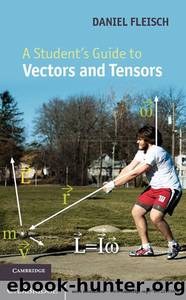Student's Guide to Vectors and Tensors (9781139766654) by Fleisch Daniel

Author:Fleisch, Daniel
Language: ita
Format: epub
Publisher: Cambridge Univ Pr
Published: 2012-01-15T00:00:00+00:00
As you might expect from the discussion of curl in Chapter 2, the magnetic field around a current-carrying wire has zero curl:
As in the case of the divergence of the electric field, which has a non-zero value only at locations at which charge exists, the only locations at which the curl of the magnetic field is non-zero are locations at which current exists (that is, at the singularity point r = 0).
Other uses of vectors and vector operations come about when you consider the force (B) produced by a magnetic field () on a moving electric charge (q). This force is given by the vector equation
(3.37)
where is the velocity of the charged particle with respect to the magnetic field. The magnitude of the force is readily found using the definition of the magnitude of the vector cross product (| à | = |||| sin θ):
(3.38)
where θ is the angle between vector and vector .
Examined carefully, Eqs. 3.37 and 3.38 can tell you a great deal about how magnetic fields affect charged particles. Compare these equations to Eq. 3.27 (E = q), and note that there are similarities and differences between electric and magnetic forces:
⢠Similarity: Both are directly proportional to the amount of charge (q);
⢠Similarity: Both are directly proportional to the field strength ( or );
⢠Difference: The velocity () of the particle appears in the magnetic equation;
⢠Difference: The magnetic force depends on the angle between the velocity and the magnetic field;
⢠Difference: The magnetic force is perpendicular to both the velocity and the magnetic field.
The similarities seem reasonable: both electric and magnetic forces are stronger if the fields are stronger and if the amount of charge is greater. Also, charges with opposite signs feel forces in opposite directions. The first listed difference (the fact that the magnetic force depends on the velocity of the particle) has the interesting consequence that a charged particle at rest with respect to the magnetic field ( = 0) feels no force whatsoever from that field. And for particles moving with respect to the magnetic field, the faster the particle moves, the stronger the magnetic force becomes.
The presence of the vector cross product in the magnetic force equation also has some important consequences. One of those consequences is that charged particles moving in a direction parallel or antiparallel to the magnetic field feel zero magnetic force. Thatâs because in both the parallel (θ = 0°) and antiparallel (θ = 180°) cases, the sine term in Eq. 3.38 is zero. So the closer the angle θ between and is to 90°, the stronger the magnetic force.
Another consequence of the vector cross product in Eq. 3.37 is that the magnetic force (B) can never point in the direction of the magnetic field, since the vector result of the cross product is by definition perpendicular to both vectors forming the product ( and in this case). For this same reason, the magnetic force can never point in the direction of the particleâs velocity vector, and must in fact be perpendicular to that vector.
Download
This site does not store any files on its server. We only index and link to content provided by other sites. Please contact the content providers to delete copyright contents if any and email us, we'll remove relevant links or contents immediately.
The Complete Stick Figure Physics Tutorials by Allen Sarah(7253)
Secrets of Antigravity Propulsion: Tesla, UFOs, and Classified Aerospace Technology by Ph.D. Paul A. Laviolette(5229)
Thing Explainer by Randall Munroe(3838)
The River of Consciousness by Oliver Sacks(3488)
The Order of Time by Carlo Rovelli(3088)
How To by Randall Munroe(2956)
A Brief History of Time by Stephen Hawking(2902)
I Live in the Future & Here's How It Works by Nick Bilton(2892)
The Great Unknown by Marcus du Sautoy(2605)
What If?: Serious Scientific Answers to Absurd Hypothetical Questions by Randall Munroe(2576)
Midnight in Chernobyl by Adam Higginbotham(2424)
Blockchain: Ultimate Step By Step Guide To Understanding Blockchain Technology, Bitcoin Creation, and the future of Money (Novice to Expert) by Keizer Söze(2402)
Networks: An Introduction by Newman Mark(2292)
The Meaning of it All by Richard Feynman(2259)
Easy Electronics by Charles Platt(2242)
The Tao of Physics by Fritjof Capra(2196)
Midnight in Chernobyl: The Untold Story of the World's Greatest Nuclear Disaster by Adam Higginbotham(2119)
When by Daniel H Pink(2050)
Introducing Relativity by Bruce Bassett(2040)
